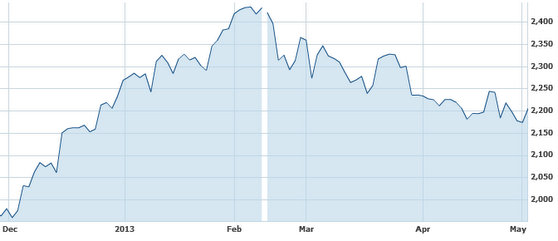Main reference: Story in China Economic Times
THE NEW NATIONAL leadership in Beijing is still getting its feet wet on policy matters.
But one frequent refrain from the top is the goal of achieving the “Chinese Dream.”
Will this policy help get a legitimate bull run going in the country’s capital markets?
The Shanghai Composite Index, the benchmark tracker of Shanghai- and Shenzhen-listed shares, has been showing signs of life again lately.
 The Chinese consumer and the 'Chinese Dream' are joined at the hip. NextInsight file photoShares are currently at around 2,236 which is 15% ahead of lows set in December last year, but still down over 10% from year-earlier levels.
The Chinese consumer and the 'Chinese Dream' are joined at the hip. NextInsight file photoShares are currently at around 2,236 which is 15% ahead of lows set in December last year, but still down over 10% from year-earlier levels.
This spring saw the transition to a new president, premier and Cabinet in Beijing and the team has pledged to help usher in the “Chinese Dream,” which centers around a booming economy, a fast-growing middle class and greater income equality across the country.
Analysts see no reason why if the three pillars of the Dream were to become reality, then the country’s listed enterprises would also benefit from the collective national reverie.
While any economist or market watcher worth his salt knows that equity markets cannot be driven and sustained by government fiat alone, support from the top is important nevertheless.
The game of golf is, as they say, 10% physical and 90% mental.
A similar analogy could be drawn for bourse behavior in that market sentiment might be half due to actual, physical, tangible and intrinsic demand for shares in the marketplace.
Meanwhile, the other half could be said to derive from intangibles like confidence and the concept of policy support from above – whether in Beijing or at the provincial government level.
Therefore, by repeating the slogan “Chinese Dream” over and over, especially coming most often from the lips of the president, the positive upside to sentiment in the investing community can only rub off in a good way.
China has for years been struggling to come up with an alternative growth plan to massive investment and export-led economic expansion.
The Wall Street crash nearly half a decade ago made the campaign all the more urgent as external demand from China – the “factory of the world” – dried up seemingly overnight.
Since then, the outgoing and newly arrived national governments have been pushing the idea of domestic consumption, a notion relatively foreign to the savings-happy and export savvy Chinese population.
Chinese shares have not been immune to the phenomenon wherein bear markets tend to drag on interminably whereas bull runs seem to come and go before one has a chance to appreciate things.
 China shares recent performance. Source: Yahoo Finance
China shares recent performance. Source: Yahoo Finance
The relatively long upswing in 2006 and 2007, prior to the Wall Street crash of 2008, was an exception and made many a millionaire in China.
But that bull market came during a time of massive trade surpluses and a seemingly limitless amount of investment – both foreign and domestic-sourced – in new Chinese factories, real estate and capital infrastructure.
Now that the US economy is showing surprising resiliency and Europe continues to get its financial house in order, the world is likely to be knocking once again on the doors of China’s exporters.
Meanwhile, along with the boost in domestic consumption for Chinese retailers, pharmaceuticals, automakers and a countless array of other sectors – all boosted in large part by the collective chasing of the proverbial “Chinese Dream” – the perfect storm could soon be in place to ensure another extended bull market for PRC equities.
The "Chinese Dream" could be the long-awaited wake up call for Chinese equities.
See also:
CHINA RETAIL: 3 House Takes

